Optimization of Thermal Environment in Cruise Ship Atriums Using CFD Simulation and Air Distribution Strategies
Abstract
1. Introduction
- (a)
- coupling radiative and conductive thermal loads in ISO-compliant boundary conditions within the CFD model;
- (b)
- providing a multi-criteria evaluation framework that simultaneously quantifies thermal comfort and ventilation effectiveness;
- (c)
- proposing engineering parameters—such as diffuser area and balanced airflow allocation—to achieve uniform temperature distribution and improved passenger comfort in large maritime public spaces.
2. Turbulence Model Selection and Experimental Validation with Thermal Environment Evaluation in Cruise Ship Atriums
2.1. Selection of Turbulence Models
2.2. Experimental Scheme for Temperature Measurement in the Cruise Ship Atrium
2.3. Construction and Validation of the Atrium Numerical Simulation Model
3. Calculation of Air-Conditioning Thermal Load in the Cruise Ship Atrium
3.1. Design Parameters of the Atrium
3.2. Calculation of Total Thermal Load and Required Air Supply in the Atrium
4. Numerical Simulation Analysis of the Thermal Environment in the Cruise Ship Atrium
4.1. Evaluation Indicators for Atrium Thermal Environment
4.2. Selection of Representative Planes and Measurement Points
4.3. Grid Independence Verification
4.4. Thermal Environment Analysis Under Different Air Supply Schemes
4.4.1. Boundary Conditions of Air Supply Schemes
4.4.2. Temperature Field Analysis
4.4.3. PMV Analysis
4.4.4. Velocity Field Analysis
4.4.5. Air Age Analysis
5. Conclusions
- Experimental validation demonstrated that the RNG - model more precisely replicated the vertical temperature distribution of the atrium in comparison to the regular - model. This underscores its appropriateness for recreating expansive, layered environments like cruise ship atriums.
- Augmenting diffuser regions (Cases 3 and 5) markedly enhanced the homogeneity of temperature distributions, mitigated localized overheating, and facilitated more efficient air exchange. Case 5, characterized by an increased supply capacity, further improved airflow homogeneity but exhibited only slight enhancements in thermal comfort compared to Case 3.
- The redistribution of airflow towards the corridors (Case 2) significantly diminished high-temperature areas adjacent to the corridors; nevertheless, it elevated the temperature and PMV values in the central hall, highlighting the trade-off between localized enhancement and overall comfort.
- Simply augmenting the quantity of corridor diffusers without modifying the supply volume (Case 4) led to airflow disruption and enlarged high-velocity areas, therefore undermining comfort. This suggests that diffuser dimensions and air volume are more essential than the number of diffusers in attaining a balanced interior atmosphere.
- The examination of thermal comfort indicators, such as PMV and air age, indicated that the majority of schemes sustained PMV between −0.15 and 0.45, reflecting slightly warm yet tolerable circumstances. Case 3 exhibited the most equitable performance, integrating temperature homogeneity, diminished air age, enhanced airflow organization, and consistent comfort levels.
Author Contributions
Funding
Institutional Review Board Statement
Data Availability Statement
Acknowledgments
Conflicts of Interest
Abbreviations
| CFD | Computational Fluid Dynamics |
| BES | Building Energy Simulation |
| JOS | Joint System Thermoregulation Model |
| RNG | Renormalization Group |
| HVAC | Heating, Ventilation, and Air Conditioning |
| PMV | Predicted Mean Vote |
| LMA | Local Mean Age of Air |
| ISO | International Organization for Standardization |
| PPD | Predicted Percentage of Dissatisfied |
| HAP | Hourly Analysis Program |
| DeST | Designer’s Simulation Toolkits |
| LED | Light Emitting Diode |
| ASHRAE | American Society of Heating, Refrigerating and Air-Conditioning Engineers |
References
- Palella, B.I.; Quaranta, F.; Riccio, G. On the Management and Prevention of Heat Stress for Crews Onboard Ships. Ocean Eng. 2016, 112, 277–286. [Google Scholar] [CrossRef]
- Jin, Z.; Qi, X. Study on Heat Load Characteristics of Ship Refrigeration Systems. China Ship Res. 2007, 3, 59–62. (In Chinese) [Google Scholar]
- Charisis, G.C.; Karakatsanis, S.T. Calculation Methods for a Complete Air Conditioning Study: Case Study of an Industrial Installation. Struct. Surv. 2012, 30, 460–474. [Google Scholar] [CrossRef]
- Wu, R. Research and Application of Rapid Load Calculation Software. Master’s Thesis, Hunan University, Changsha, China, 2012. (In Chinese). [Google Scholar]
- Thiangchanta, S.; Chatchawan, C. The Multiple Linear Regression Models of Heat Load for Air-Conditioned Rooms. Energy Rep. 2020, 6, 972–977. [Google Scholar] [CrossRef]
- AlHarbi, F. Comparison of Cooling Load Calculations by E20 and HAP Software. Univ. J. Mech. Eng. 2019, 7, 285–298. [Google Scholar] [CrossRef]
- Zhao, H.; Li, Y.; Zhang, T.; Chen, Y.; Wang, X.; Liu, M.; Sun, Q.; Gao, R.; Zhou, P.; Xu, L.; et al. Analysis of Thermal Environment, Energy Consumption Changing Patterns, and Influencing Factors in Large Spaces Based on Dynamic Co-simulation Platform. J. Build. Eng. 2025, 103, 112049. [Google Scholar] [CrossRef]
- Luo, Q.; Ou, C.; Li, Y.; Luo, Z.; Tian, W.; Zeng, L.; Hang, J. Optimal Natural and HVAC Ventilation to Balance Passenger Infection Risk and Thermal Comfort across Seasons on a Cruise Ship. Build. Environ. 2025, 282, 113306. [Google Scholar] [CrossRef]
- ISO 7730:2025; Ergonomics of the Thermal Environment—Analytical Determination and Interpretation of Thermal Comfort Using Calculation of The PMV and PPD Indices and Local Thermal Comfort Criteria. International Organization for Standardization: Geneva, Switzerland, 2025.
- Zhou, B.; Huang, Y.; Nie, J.; Ding, L.; Sun, C.; Chen, B. Modification and Verification of the PMV Model to Improve Thermal Comfort Prediction at Low Pressure. J. Therm. Biol. 2023, 117, 103722. [Google Scholar] [CrossRef] [PubMed]
- Fiala, D.; Havenith, G. Modelling Human Heat Transfer and Temperature Regulation. In The Mechanobiology and Mechanophysiology of Military-Related Injuries; Gefen, A., Epstein, Y., Eds.; Studies in Mechanobiology, Tissue Engineering and Biomaterials; Springer: Cham, Switzerland, 2016; Volume 19, pp. 265–302. [Google Scholar] [CrossRef]
- Mateus, M.N.; Graça, D.C.G. Simulated and Measured Performance of Displacement Ventilation Systems in Large Rooms. Build. Environ. 2017, 114, 470–482. [Google Scholar] [CrossRef]
- Chu, G.; Liu, X.; Gao, Q.; Guo, X.; Shen, W. Influence of Air Supply Parameters of Building Atrium on Air Conditioning Effect in Winter. Procedia Eng. 2017, 205, 1913–1919. [Google Scholar] [CrossRef]
- Wang, L.; Kumar, P.; Makhatha, M.E.; Jagota, V. Numerical Simulation of Air Distribution for Monitoring the Central Air Conditioning in Large Atrium. Int. J. Syst. Assur. Eng. Manag. 2021, 13 (Suppl. S1), 340–352. [Google Scholar] [CrossRef]
- Che, C.; Lv, Z.; Wei, J.; Wang, X.; Zhao, M. Optimization of Atrium Thermal Environment in Summer Based on DeST Platform. Integr. Ferroelectr. 2023, 236, 109–129. [Google Scholar] [CrossRef]
- Kim, G.; Schaefer, L.; Lim, T.S.; Kim, J.T. Thermal Comfort Prediction of an Underfloor Air Distribution System in a Large Indoor Environment. Energy Build. 2013, 64, 323–331. [Google Scholar] [CrossRef]
- Nada, S.A.; El-Batsh, H.M.; Elattar, H.F.; Ali, N.M. CFD Investigation of Airflow Pattern, Temperature Distribution and Thermal Comfort of UFAD Systems for Theater Buildings. J. Build. Eng. 2016, 6, 274–300. [Google Scholar] [CrossRef]
- ISO 7547:2022; Ships and Marine Technology—Air-Conditioning and Ventilation of Accommodation Spaces and Other Enclosed Compartments on Board Ships—Design Conditions and Basis of Calculations. International Organization for Standardization: Geneva, Switzerland, 2022.
- GB/T 13409–1992; Design Conditions and Calculation Methods for Air-Conditioning and Ventilation of Ship Accommodation Spaces. Chinese Standards Press: Beijing, China, 1992.
- Wu, Y.; Tang, W.; Wang, M.; Wang, Y.; Deng, Q. Study on New Natural Ventilation Performance Based on Seat Air Supply in Gymnasiums. Buildings 2025, 15, 1600. [Google Scholar] [CrossRef]

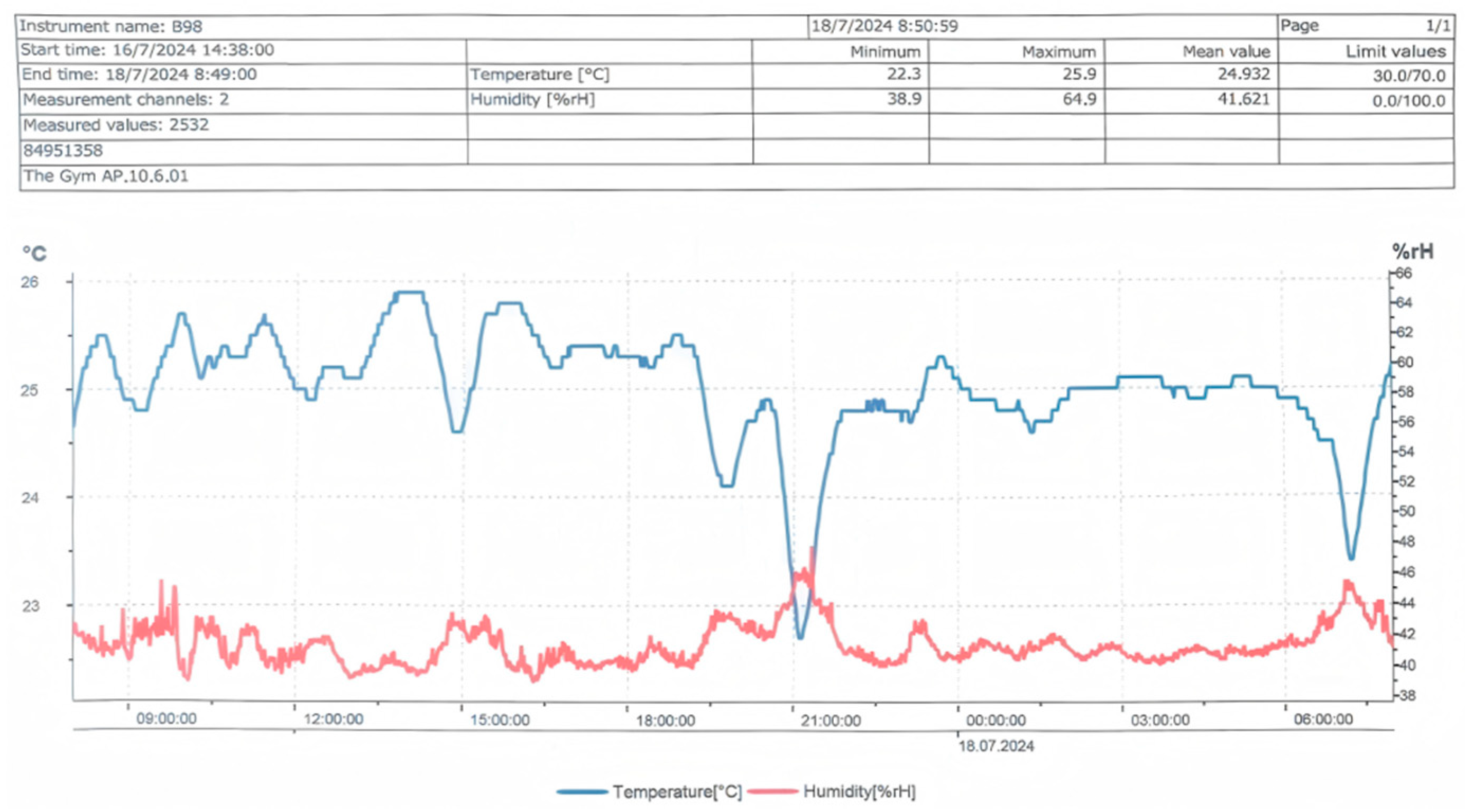

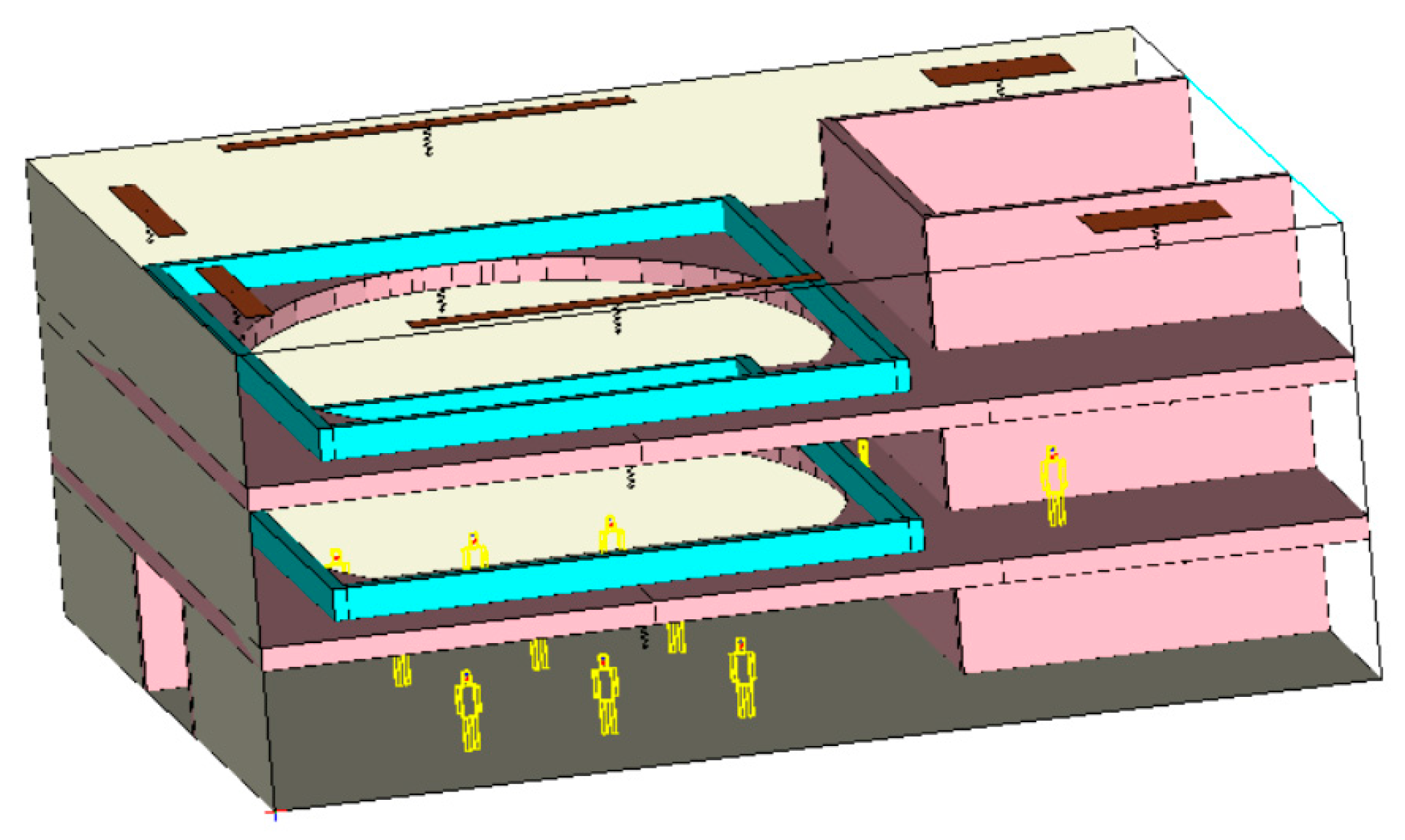

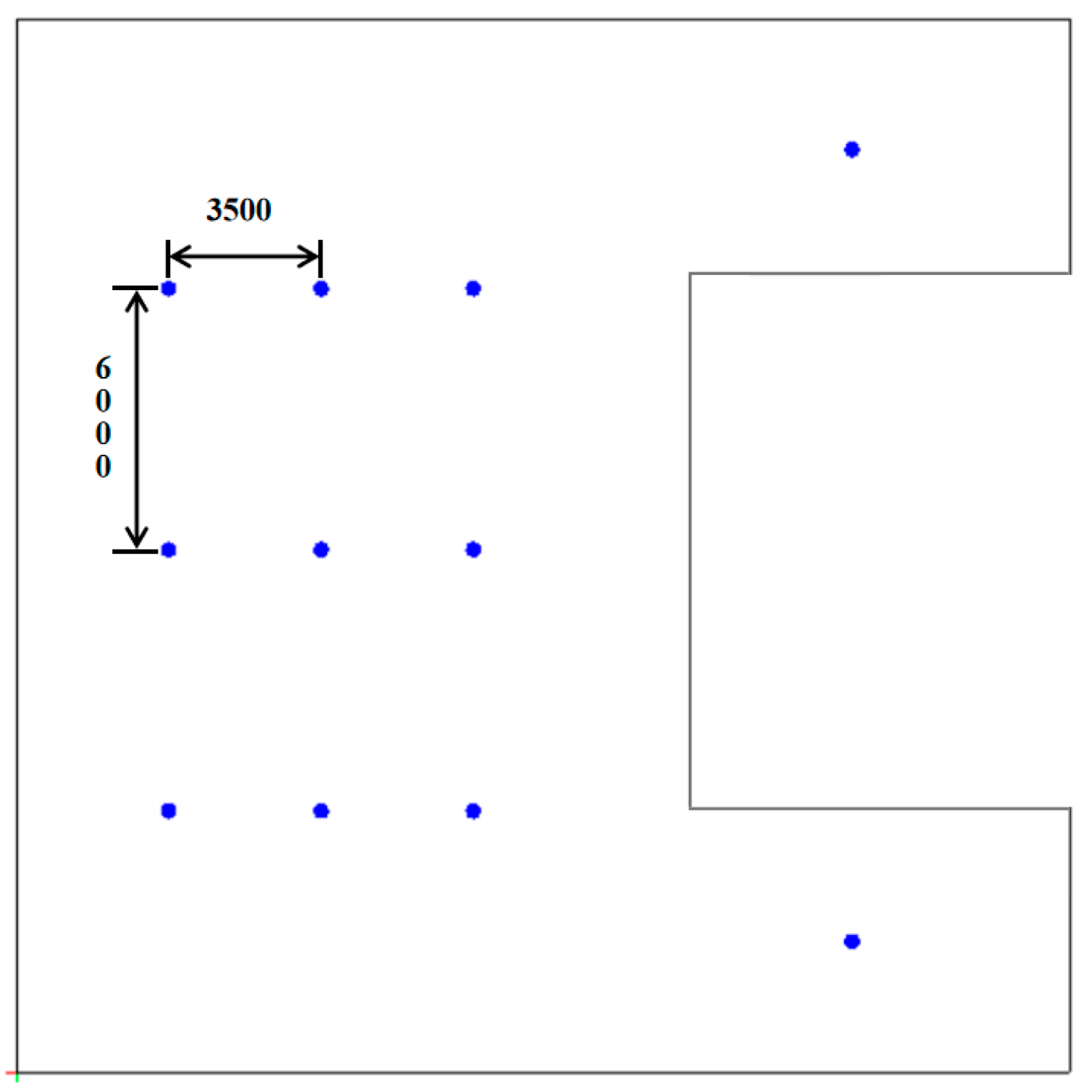



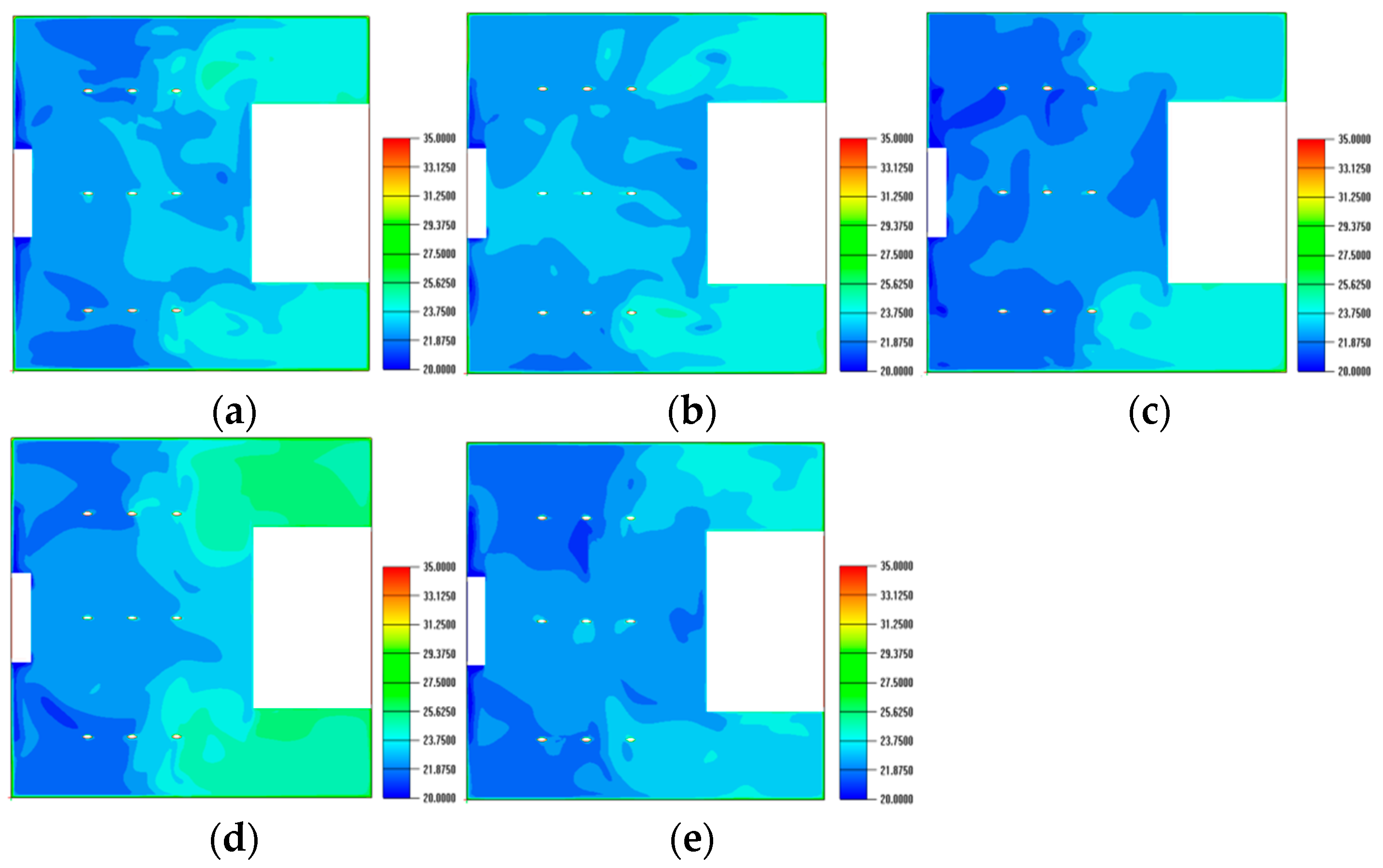
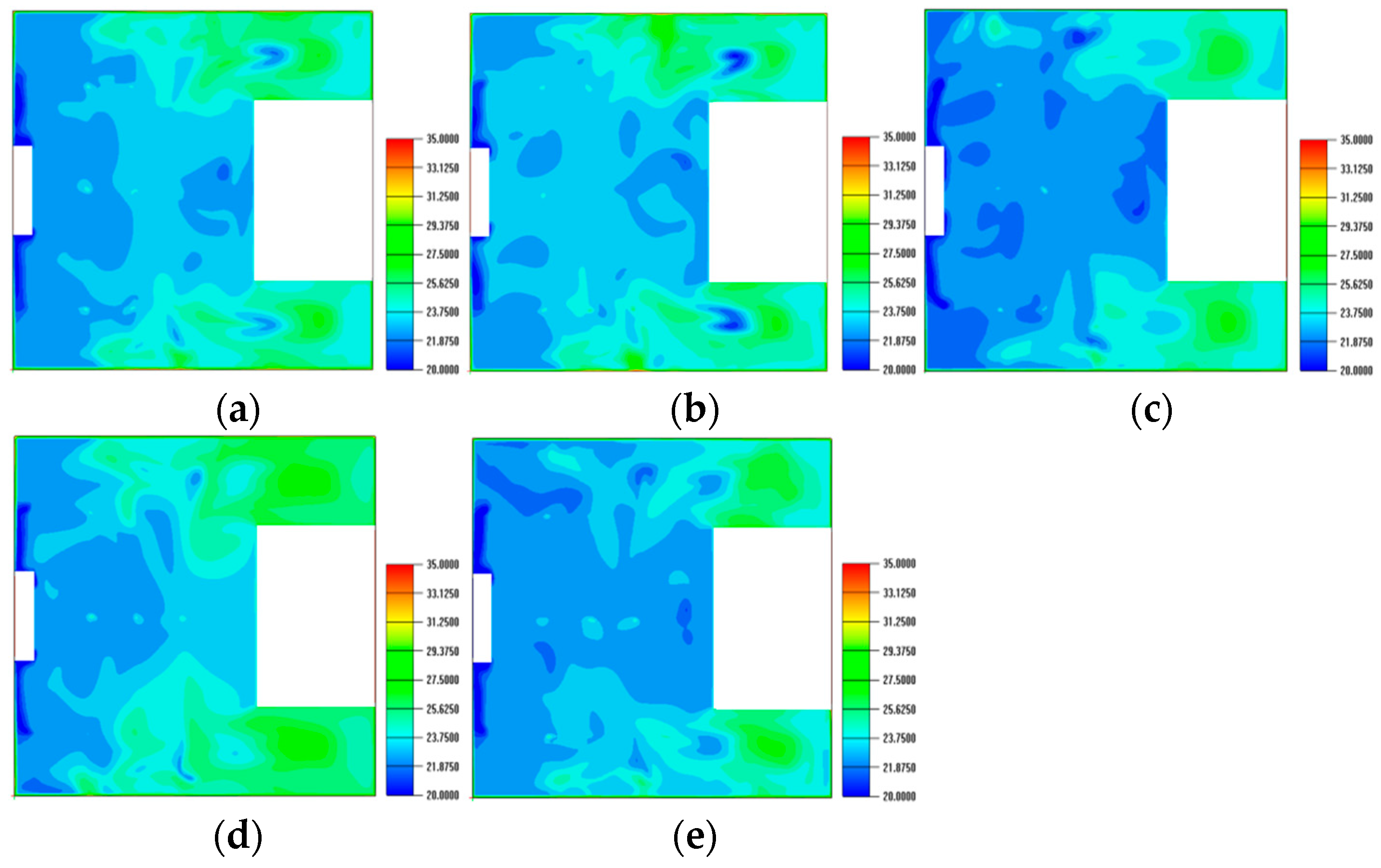
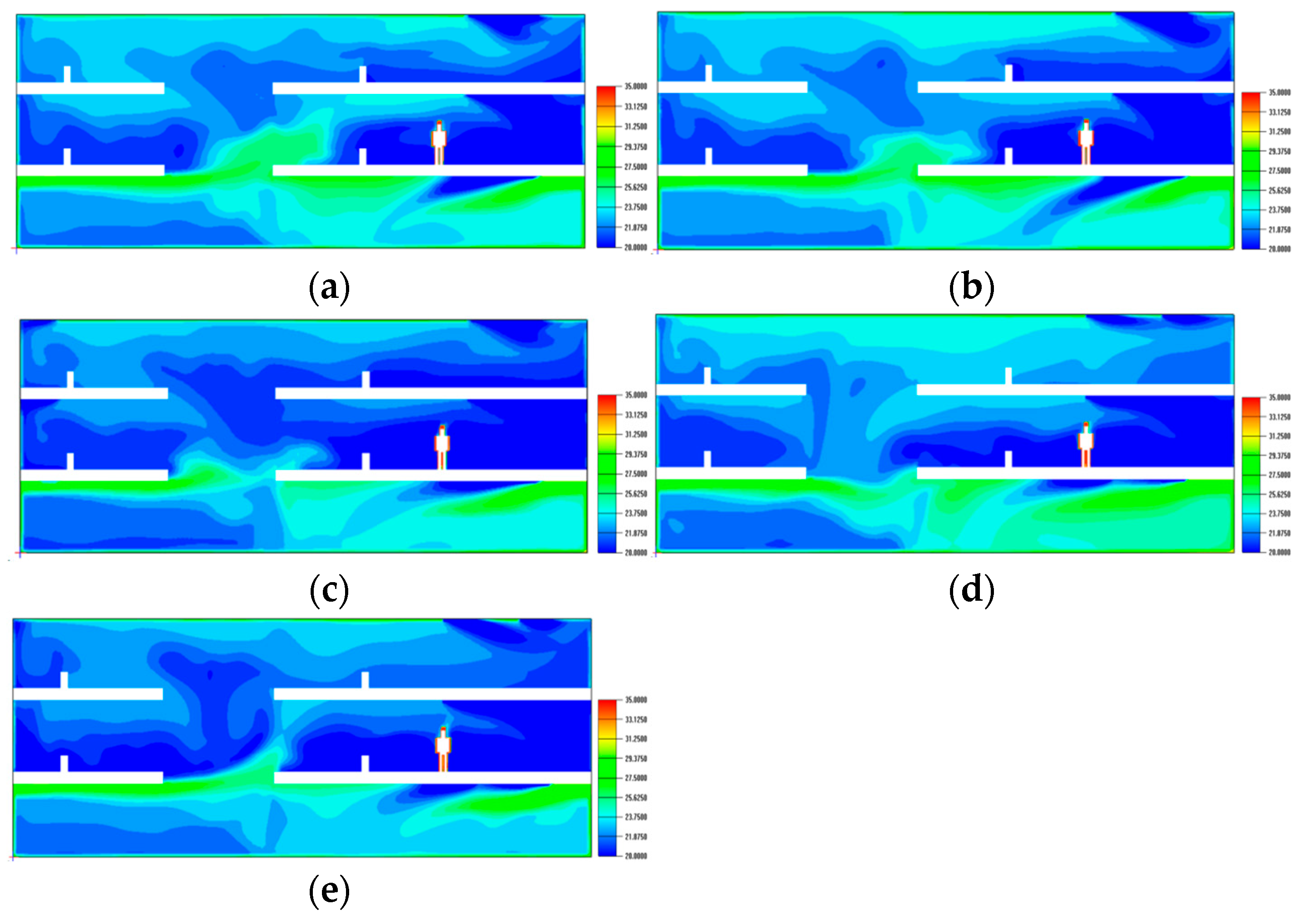
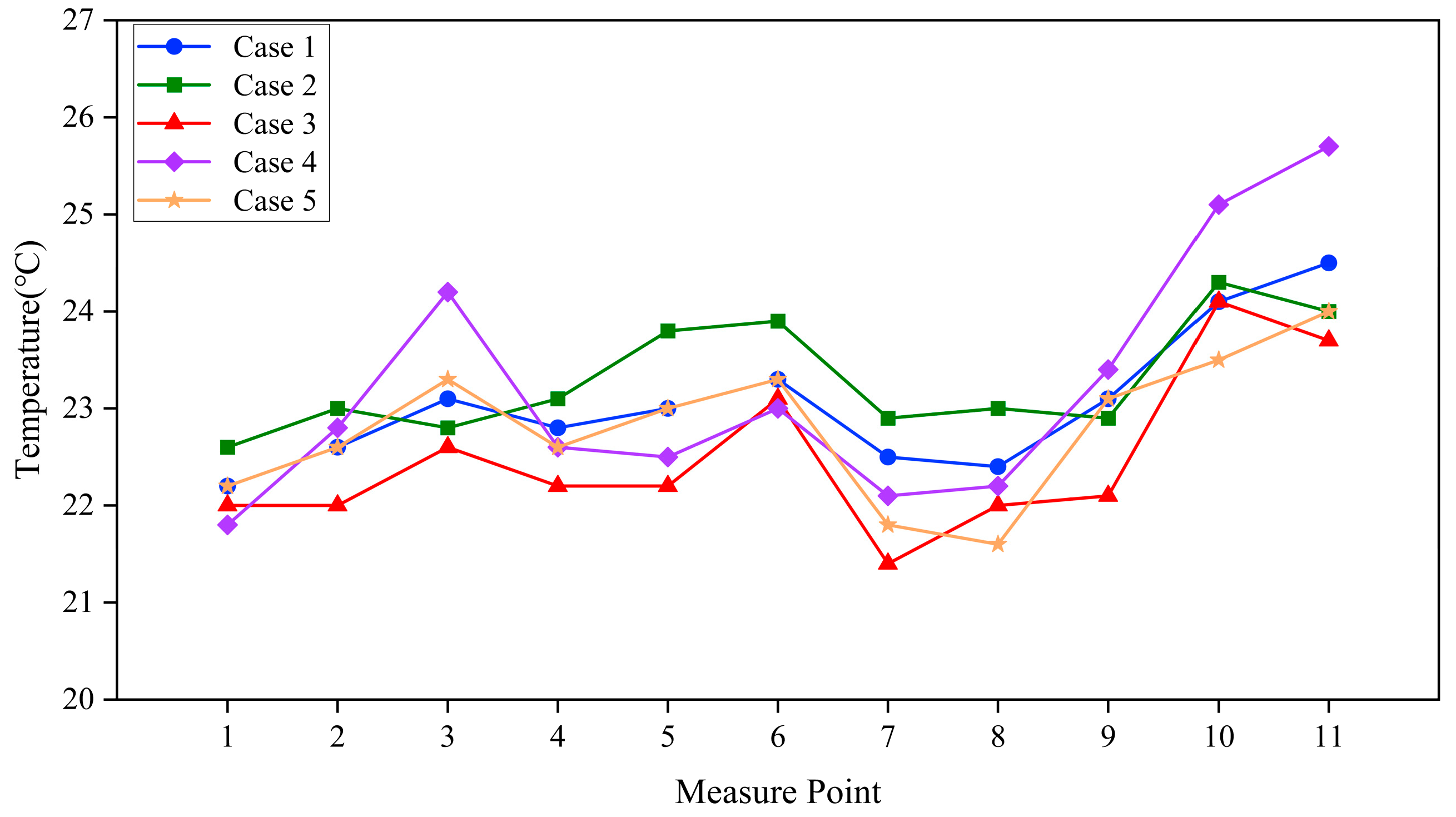
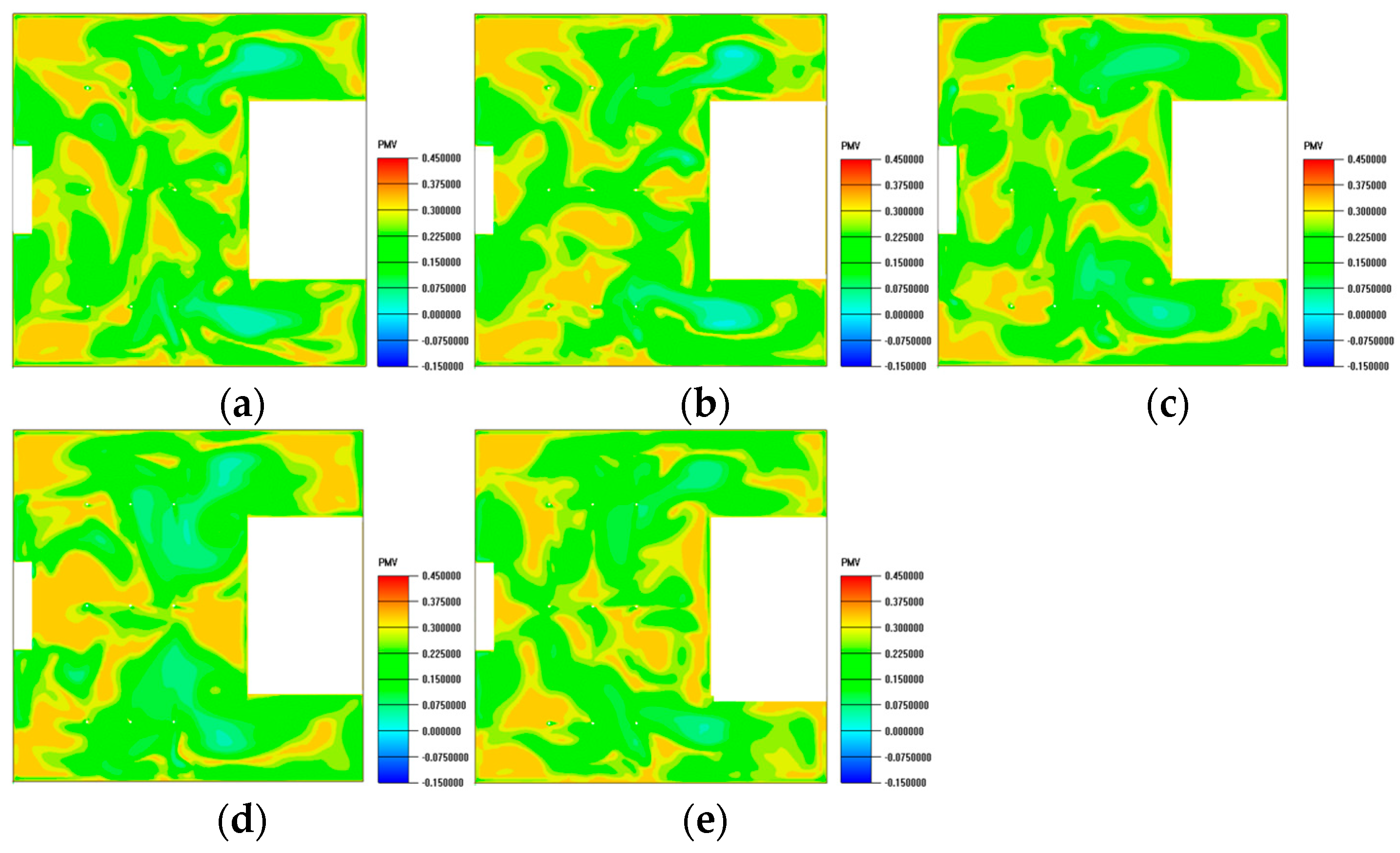


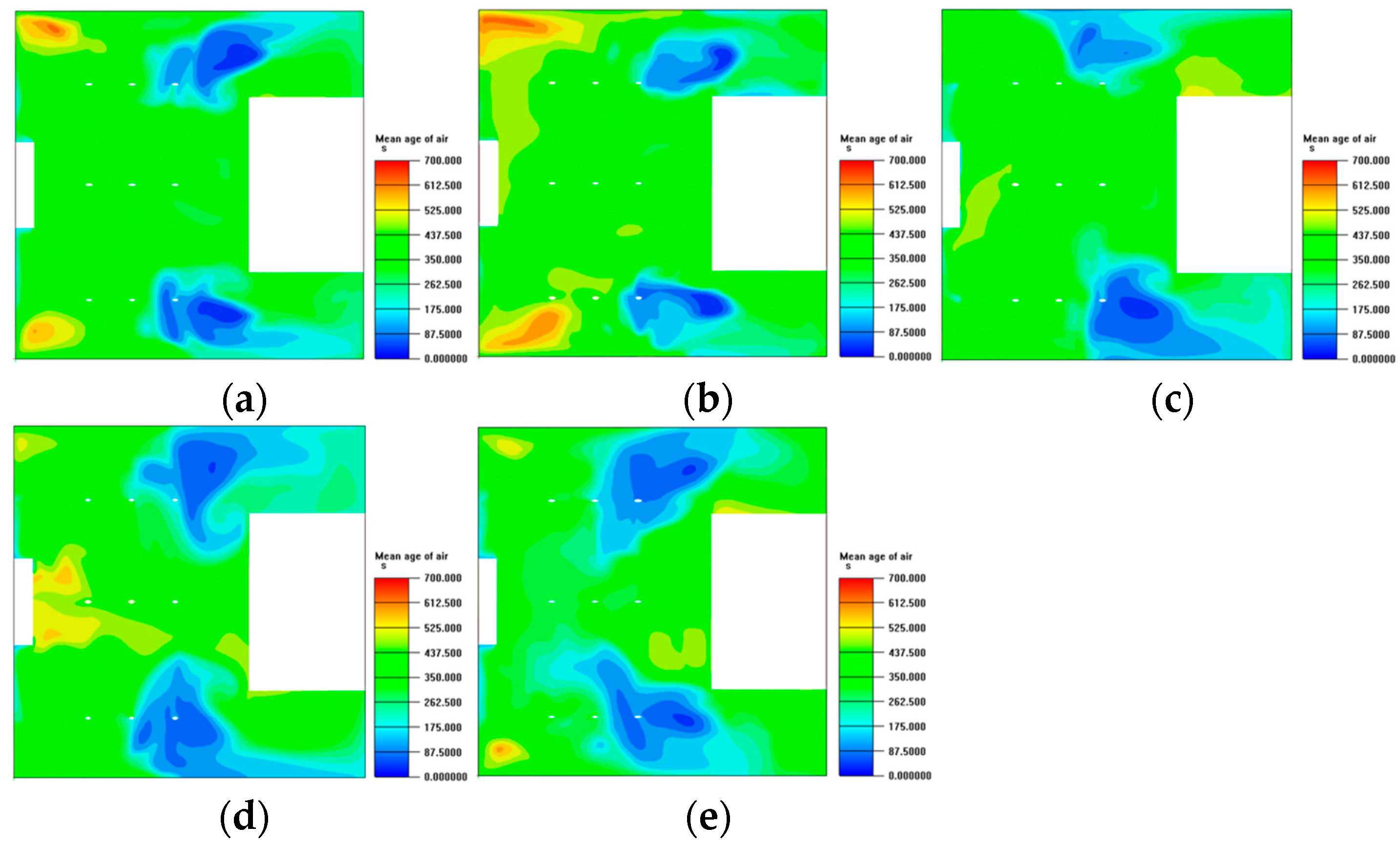
| Parameter | |||||||
|---|---|---|---|---|---|---|---|
| Value | 0.0845 | 1.39 | 1.39 | 1.42 | 1.68 | 0 | 4.377 |
| Point | Experimental (°C) | Standard Model (°C) | Error (%) | RNG Model (°C) | Error (%) |
|---|---|---|---|---|---|
| A01 | 24.1 | 23.6 | 2.1 | 23.4 | 2.9 |
| A02 | 24.4 | 23.6 | 3.3 | 23.8 | 2.5 |
| A03 | 24.6 | 23.6 | 4.1 | 24.1 | 2.0 |
| B01 | 24.3 | 24 | 1.2 | 23.5 | 3.3 |
| B02 | 24.4 | 23.9 | 2.1 | 23.6 | 3.3 |
| B03 | 24.3 | 24 | 1.2 | 23.5 | 3.3 |
| C01 | 23 | 23.3 | 1.3 | 22.7 | 1.3 |
| C02 | 22.9 | 23.3 | 1.8 | 22.4 | 2.2 |
| C03 | 23.1 | 23.4 | 1.3 | 22.2 | 3.9 |
| D01 | 26.3 | 24.4 | 7.2 | 25 | 4.9 |
| D02 | 26.5 | 24.7 | 6.8 | 25.2 | 4.9 |
| D03 | 26.6 | 25.2 | 5.3 | 25.3 | 4.9 |
| E01 | 23.1 | 22.8 | 1.3 | 22.2 | 3.9 |
| E02 | 24 | 23 | 4.17 | 23.5 | 2.08 |
| E03 | 24.3 | 23.3 | 4.12 | 23.7 | 2.47 |
| F01 | 24 | 22.9 | 4.58 | 23.8 | 0.83 |
| F02 | 24.8 | 22.9 | 7.66 | 24.9 | 0.4 |
| F03 | 24.9 | 23.3 | 6.43 | 24.7 | 0.8 |
| G01 | 26.2 | 24.5 | 6.49 | 25.4 | 3.05 |
| G02 | 26.5 | 24.7 | 6.79 | 25.5 | 3.77 |
| G03 | 26.8 | 25.2 | 5.97 | 26 | 2.99 |
| Condition | Dry-Bulb Temperature (°C) | Relative Humidity (%) |
|---|---|---|
| Indoor | 24 | 55 |
| Outdoor | 35 | 80 |
| Thermal Sensation | Hot | Warm | Slightly Warm | Neutral | Slightly Cool | Cool | Cold |
|---|---|---|---|---|---|---|---|
| PMV | +3 | +2 | +1 | 0 | −1 | −2 | −3 |
| Case | Supply Air Volume (m3/s) | Supply Area (m2) | Number of Diffusers | Exhaust Method | Exhaust Area (m2) |
|---|---|---|---|---|---|
| Case 1 | 3.0 | 30 | 6 | Side return | 7 |
| Case 2 | 3.0 (redistributed) | 30 | 6 | Side return | 7 |
| Case 3 | 3.0 | 45 | 6 | Side return | 7 |
| Case 4 | 3.0 | 30 | 8 | Side return | 7 |
| Case 5 | 3.0 | 36 | 8 | Side return | 7 |
Disclaimer/Publisher’s Note: The statements, opinions and data contained in all publications are solely those of the individual author(s) and contributor(s) and not of MDPI and/or the editor(s). MDPI and/or the editor(s) disclaim responsibility for any injury to people or property resulting from any ideas, methods, instructions or products referred to in the content. |
© 2025 by the authors. Licensee MDPI, Basel, Switzerland. This article is an open access article distributed under the terms and conditions of the Creative Commons Attribution (CC BY) license (https://creativecommons.org/licenses/by/4.0/).
Share and Cite
Li, D.; Zeng, J.; Bai, Y.; Zhang, X.; Gu, H.; Lu, N.; Qiang, D.; Wang, K. Optimization of Thermal Environment in Cruise Ship Atriums Using CFD Simulation and Air Distribution Strategies. Energies 2025, 18, 5772. https://doi.org/10.3390/en18215772
Li D, Zeng J, Bai Y, Zhang X, Gu H, Lu N, Qiang D, Wang K. Optimization of Thermal Environment in Cruise Ship Atriums Using CFD Simulation and Air Distribution Strategies. Energies. 2025; 18(21):5772. https://doi.org/10.3390/en18215772
Chicago/Turabian StyleLi, Di, Ji Zeng, Yichao Bai, Xinqiao Zhang, Haoyun Gu, Nan Lu, Dawei Qiang, and Ke Wang. 2025. "Optimization of Thermal Environment in Cruise Ship Atriums Using CFD Simulation and Air Distribution Strategies" Energies 18, no. 21: 5772. https://doi.org/10.3390/en18215772
APA StyleLi, D., Zeng, J., Bai, Y., Zhang, X., Gu, H., Lu, N., Qiang, D., & Wang, K. (2025). Optimization of Thermal Environment in Cruise Ship Atriums Using CFD Simulation and Air Distribution Strategies. Energies, 18(21), 5772. https://doi.org/10.3390/en18215772





